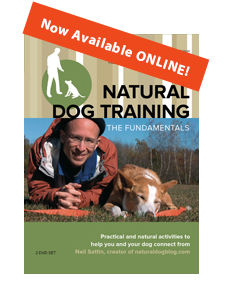A week or so ago, we talked about another major question that you can answer for your dog: Where is the Danger? In this article I'm going to give you a more advanced exercise in defining "the danger" for your dog. Please make sure that you've read the first article about "where's the danger?" before continuing. Remember that your predator work should be something that you do only after you have a solid foundation in doing all of the prey-related work (particularly pushing).
Advanced exercise in identifying "the danger" for your dog
Major predator. For this exercise, you're going to need an assistant, and a place to go (like a trail in the woods) where you will certainly be undisturbed by other people. Agree ahead of time on a place in the trail where the "action" is going to occur. Your assistant is going to be the "predator", so make sure that you have given them all the details on how to be predator-like (see the first article for a comprehensive list). It will also be helpful if your assistant dresses so as to look a bit different - additional layers of clothes, a big hat, sunglasses. The extra layers are also helpful in deterring insect bites (a plus for the assistant).
IMPORTANT WARNING: This exercise digs really deep into your dog's emotional repertoire. If at any time it feels like this is "too much" for your dog, end the exercise. Since you are going to be keeping your dog close to you (with a leash) during the exercise, there is a chance that overstimulation could lead them to bite you. So stay in tune with your dog, and use "the retreat" (as described below) to effectively manage your dog's stress level. The goal of the exercise is to get deep within your dog's emotional reserves (often heralded by a deep, resonant barking) - but you need to remain calm and objective, ending the exercise early if it seems necessary (especially if your dog shows any signs of impending aggression towards you). You choose to do this exercise at your own risk.
ALSO IMPORTANT: Potential aggression (growling, barking) towards the predator (who will never get within 100 feet of you) is fine. However, make sure that you DO NOT release the leash at any time (and make sure in advance that your dog can't slip their collar). You do NOT want your assistant to get bitten. DO NOT DO NOT DO NOT release the leash. Make sure that your assistant has a tasty treat or two with them. Should your dog get loose, your assistant should not run away (which would encourage the chase). Have them remove their hat and sunglasses (if wearing them) to transform back into "friendly person you know", at which point they can talk to the dog ("good dog") and offer treats. They should keep a big stick handy - just in case. Be a responsible pet owner and KEEP A GOOD HOLD ON THE LEASH AT ALL TIMES - and you'll never have to worry about any of this - and use a LONG LEASH so that, in the off chance that you do lose hold on the leash, you can get back to the leash that much more quickly. Make sure your assistant has read this article AND the previous article on "Where's the Danger?" Make sure that your assistant understands and feels comfortable with the risk involved. Your assistant also chooses to do this exercise at their own risk.
Let your assistant head out into the woods before you go. If possible, have your assistant approach the spot from a different direction than how you are going to be approaching with your dog. For instance, if the trail is a loop, they can enter one way, and you can enter the other way. Or they can just hike through the woods to get to the agreed upon place. If there's no choice but to take the same route, allow your assistant ample time to get to their appointed spot - so that their scent (which will probably be familiar to your dog) will have dissipated somewhat by the time you approach. It'll still be there, of course - you just want to minimize its impact on your dog's experience. To that end, don't let your dog see your assistant head out down the trail.
OK, so your assistant heads out to the spot, and then should leave the trail, heading about 50 yards into the woods (or even further). If you have the choice between uphill and downhill, it's better for your assistant to head uphill (so that when you approach you'll have to look up to see "the predator"). Now your assistant hides and waits for you to arrive with your dog.
So head out on a "normal" walk into the woods with your dog. Your dog should be LEASHED. Keep it relatively relaxed and discussion-free, enabling your dog to really tune in to the sights, sounds, and smells of the trail. As you arrive at the appointed place, come to a stop, and reel your dog in (if you have let the leash out) so that your dog is right near your side with minimal slack in the leash. Wait for a few moments.
After you have arrived and waited for a minute or two, your assistant should begin their predator act. Ideally your assistant will get into the mental space of a big, bad predator who is very, very slowly stalking their prey (you and your dog). Have them start slowly - perhaps not even yet visible, but just striking a large, dead branch against a tree to make some noise. The sounds will punctuate the sonic backdrop of the scene (something your dog will definitely notice). Your assistant should approach, ever-so-slowly: crouching, pointing, breathing noisily, striking branches with a stick. It's important to not over-expose your dog to the intensity of the situation (and to allow a gradual build-up of the energy) - so make sure that your assistant takes it slow. When in doubt, they should err on the side of too slow.
Your assistant also needs to respond to your dog. Just as in the earlier exercises, if your dog lets out a bark, your assistant should run away a few paces and hide. You are giving your dog a successful way to negotiate being the recipient of that "big, bad predator" energy - they BARK and the predator responds. Listen to the quality of your dog's bark, and see if you notice it having a deeper, more resonant quality. This exercise gets into the core of your dog's experience to shake things loose - especially if they have some "stuck" stress.
Your dog might not bark - they might whimper, look at you nervously, or give a low, rumbling growl. You are exposing your dog to "the BIG danger" after all. You can offer your dog encouragement with a quiet, relaxed "Good dog" - but that should be the extent of your interaction with your dog in this moment - you don't want to distract your dog from the matter at hand. You should also try to gauge the extent of your dog's tension and the stress that's building within them.
Work out a hand signal with your assistant, so that you can indicate from a distance that your assistant should do the "retreat and hide" routine. It can be helpful to take the pressure off for a moment or two (which is what the running and hiding does), to allow your dog to get to the NEXT level in their experience. Notice how the retreat affects your dog's subsequent response to the predator's advance.
After your assistant runs away, they should wait a few moments and then begin their approach again. SLOWLY. If you get your dog to the "barking" stage, you'll want to let your dog go through the "bark/relax" cycle a few times. Then END the exercise by leading your dog away (they might not want to come with you - so feel free to use food as an inducement). Take some time to notice how your dog is responding to the environment now (versus your initial approach).
IMPORTANT: While the deep, resonant barking is what you're after, if it doesn't happen DON'T worry, and DON'T prolong the exercise in an attempt to get there. The whole thing should take about 15-20 minutes MAX.
ALSO IMPORTANT: Your assistant should never get closer than 100 feet. It's more important for your dog to FEEL the presence of the predator and its approach - so that's what you're after. It's the suspenseful "What is that thing in the woods coming to get me?" Your dog should never feel like it is directly being threatened by close proximity of the predator. In other words - ASSISTANT STAYS FAR AWAY. Less is more. There should never be the chance of a direct encounter between your assistant and your dog during the exercise.
Once you're well away from the site of the encounter with big predator, you can do a little pushing or tug-of-war with your dog. Your main aim is to give them a vent for any residual emotional energy that's hanging around, and to re-attract them to you (which, as you recall, is the chief aim of your "prey" work). Then give your dog some alone time to relax. The entire experience needs to gestate within them a bit, which seems to take a sleep cycle or two. So give your dog the rest of the day "off" - and resume your regularly scheduled training the next day.
One last important note: You should plan on re-introducing your dog to the person who was your assistant the next time that they meet. In other words, be cautious - everything will probably be fine, but you want to make sure that it's fine. Have your assistant feed the dog some tasty treats - you can also go through the "How to Introduce Your Dog to a Stranger" protocol. Go the extra mile to make sure that your dog is fine and relaxed with your assistant around before you allow them to freely interact.
You may only have to do this exercise once in your dog's life. You may NEVER have to do it. Anything more than once or twice (and if you did it twice you would want the experiences to be separated by a LOT of time) would be too much. Be the predator to answer the question "Where's the Danger?" for your dog (answer: it's out there in the woods), and then go back to being the MOOSE, which is the most important part of your training work. As always, let me know if you have any questions or need me to clarify any of this exercise.





Neil, I'm mulling both of these lessons over. I've started having some issues with Stevie that I thought we were well on our way to resolving. The trigger was a vet visit that did not go smoothly. He's back to his old "want to make contact, feel like I'm falling" scenario of growling at people after he's initiated contact.
I think we need to back up and review all of our lessons and make sure that foundation is solid before we take on the predator lessons.
Would you please articulate again for me how engaging in this exercise will help him? My underlying fear is that it may make him more suspicious of people. Are you saying that this kind of exercise will broaden his range of experience and sensation so that everything on his predator scale gets adjusted down a bit to less threatening relative to this new experience I'll be giving him?
Thanks Neil!
Neil, I articulated some background on the vet incident here: http://lostindog.blogspot.com/